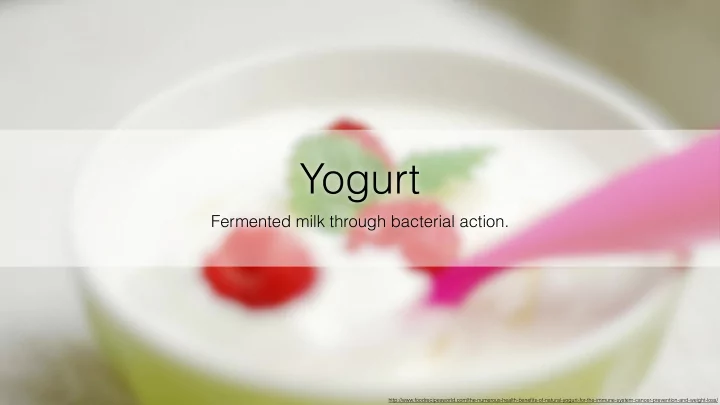

Yogurt Fermented milk through bacterial action. http://www.foodrecipesworld.com/the-numerous-health-benefits-of-natural-yogurt-for-the-immune-system-cancer-prevention-and-weight-loss/
Toppings Fermented milk yo ğ urt Turkish word for curdled or coagulated, thickened. http://www.makeyourownyogurt.com/make-yogurt/stir-well http://en.wikipedia.org/wiki/File:Yogurtland_Yogurt_High_Res.jpg
Why eat yogurt? Rich in protein, calcium, riboflavin, vitamin B6 and vitamin B12. Eating low-fat yogurt can promote weight loss. Can help keep harmful gut bacteria at bay. May discourage vaginal infections http://en.wikipedia.org/wiki/Yogurt#Nutritional_value_and_health_benefits
How is yogurt made? Lactobacillus delbrueckii Streptococcus subsp. bulgaricus thermophilus https://microbewiki.kenyon.edu/index.php/File:Lactobacillus_bulgaricus.jpg https://microbewiki.kenyon.edu/index.php/File:Streptococcus_thermophilus.jpg
How is yogurt made? L. d. bulgaricus and S. thermophilus are used together to produce lactic acid. Lactic acid coagulates milk proteins to give yogurt its thick consistency. L. d. bulgaricus produces acetaldehyde, a major compound responsible for the aroma of yogurt.
Biochemistry overview β -galactosidase metabolizes lactose to glucose. Glucose is metabolized to lactic acid through the Embden- Meyerhof-Parnas pathway. Lactic acid coagulates milk proteins to produce yogurt. https://microbewiki.kenyon.edu/index.php/File:Emp_pathway.jpg
Lactose Glucose Galactose β -galactosidase Galactose ( β 1 → 4) Glucose β -galactosidase Enzyme catabolizes lactose into galactose and glucose. https://microbewiki.kenyon.edu/index.php/File:Lactose_breakdown.jpg
Glucose Lactic acid Embden-Meyerhof-Parnas Pathway Enzymes convert glucose to lactic acid. http://2012books.lardbucket.org/books/principles-of-general-chemistry-v1.0/s09-07-end-of-chapter-material.html
Why homemade yogurt? It tastes better. No additives. It’s less expensive. Just because you can. http://en.wikipedia.org/wiki/File:Yogurtland_Yogurt_High_Res.jpg
Ingredients 1 litre of milk 3 tbsp plain yogurt as starter large pot with lid spoon to stir thermometer http://www.makeyourownyogurt.com/make-yogurt/what-you-need
Sanitize You are incubating bacteria! Need to sanitize equipment to prevent contamination. Easiest method: put your stuff in the pot and boil water to steam. http://www.makeyourownyogurt.com/make-yogurt/sanitize-equipment
Heat the milk Using the thermometer, heat the milk to 80°C for ~10 min. This denatures the milk proteins and yields a smoother texture. Careful not to burn the bottom! http://www.makeyourownyogurt.com/make-yogurt/add-your-milk
Cool the milk Using the thermometer, cool the milk to 45°C. If too hot, it will kill the bacteria! http://www.makeyourownyogurt.com/make-yogurt/cool-to-110
Add starter culture Introduce L. d. bulgaricus and S. thermophilus using the starter yogurt. Stir well. http://www.makeyourownyogurt.com/make-yogurt/pitch-your-yogurt
Keep warm overnight Now we incubate for 8-12 hours. The longer you wait, the thicker and tangy it gets. http://www.makeyourownyogurt.com/make-yogurt/stir-cover-warm
Stir and chill Stirring and chilling stops bacteria metabolism. http://www.makeyourownyogurt.com/make-yogurt/chill-overnight
You’ve made yogurt! Enjoy with your favourite flavour 😅 http://commons.wikimedia.org/wiki/File:Dessert_-_Yogurt_e_Lamponi.jpg
Recommend
More recommend